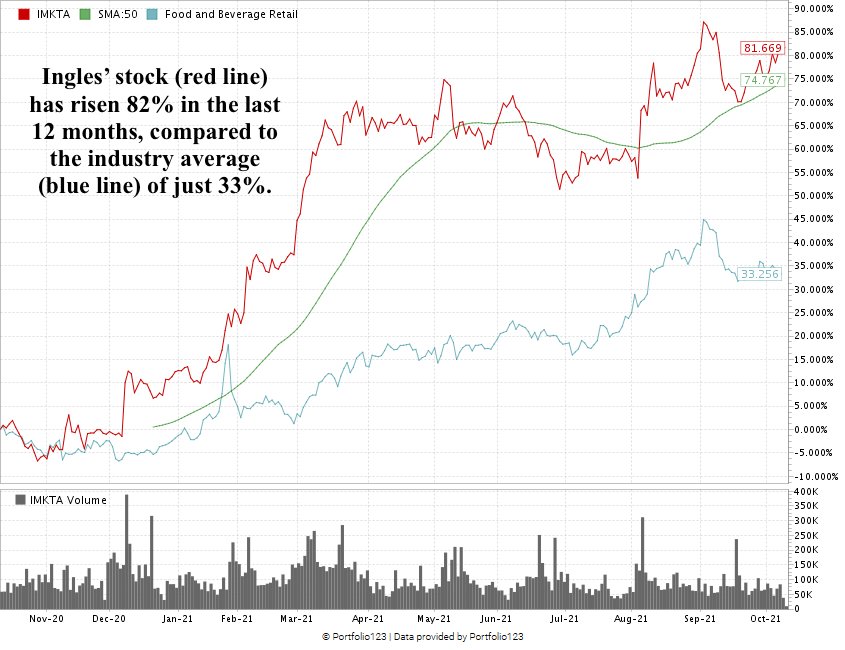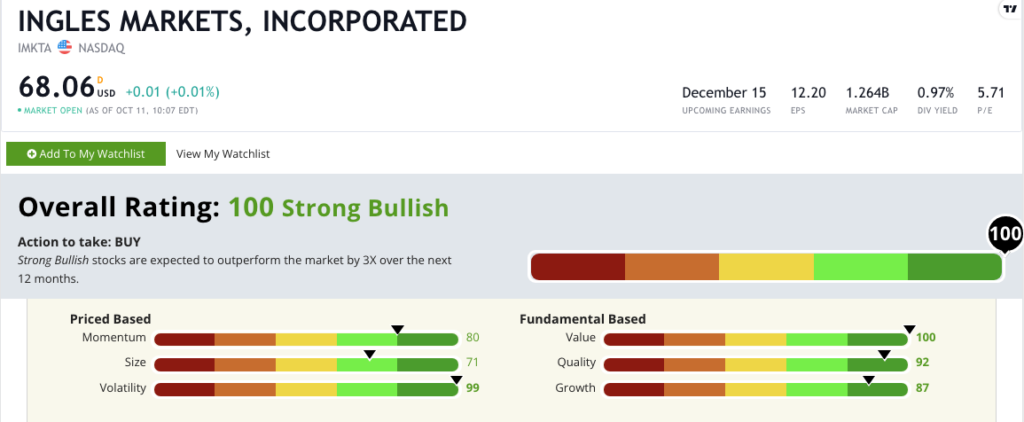During the COVID-19 pandemic, I had to develop a new grocery routine because many South Florida supermarkets were either closed or had very limited capacity.
Now, however, things are back in full swing. Supermarket parking lots are full again, and we are somewhat back to normal. I, and many others, am back to taking inventory, adding family favorites to the list and making the trek to the closest Publix to stock up.
With this return to normal, I see grocery stores shaking off weak 2020 performance and growing even stronger in the years ahead.
Using Adam O’Dell’s six-factor Green Zone Ratings system, I found a grocery store chain with strong financials and an 85% jump in its stock price over the last 12 months.
We are “Strong Bullish” on this grocery stock, which means it is poised to outperform the broader market by at least three times over the next 12 months.
What I discovered about grocery stocks can make investors profits if they act quickly.
In-Person Grocery Shopping Makes a Comeback
During the COVID-19 pandemic, grocery stores had to pivot from in-person shopping to online and delivery.
The change hit grocery store bottom lines in 2020.
The supermarket industry in the U.S. grew 20% from 2012 to 2019 as stores expanded their offerings — growing beyond the old, conventional supermarket by adding delis and bakeries in addition to traditional grocery offerings.
However, that revenue took a substantial hit in 2020 — dropping 14% in one year — thanks to a sudden halt of in-person grocery shopping due to COVID-19 lockdowns.
Shoppers weren’t utilizing those expansions as they shopped for what they needed, when they needed it.
But that is starting to change. The supermarket industry is projected to grow 27% from 2020 to 2024.
Investors can find big profits in this growing grocery stock trend.
A Commanding Regional Grocery Stock: Ingles Markets Inc.
Ingles Markets Inc. (Nasdaq: IMKTA) operates a chain of supermarkets in the Southeast United States. It is headquartered in Asheville, North Carolina.
Its locations not only offer the usual supermarket products, but pharmacies and gas stations. The company is also involved in dairy operations and shopping center retail (meaning, they own large shopping centers where their stores are used as anchors).
In all, Ingles operates 188 supermarkets under the Ingles name and nine under Sav-Mor. They are all located within 280 miles of its 1.65 million square-foot distribution and operations facility in Asheville.
Ingles’ Total Revenue Grows 21.5% from 2016 to 2020
From 2014 to 2016, Ingles had flat annual total revenue growth. That changed in 2017 after the company started remodeling a number of its locations.
Those remodels, along with the expansion of its footprint, led the company to grow its annual total revenue 21.5% — including a $400 million increase in 2020, when the overall supermarket industry suffered declines.
For the 12 months ending June 26, 2021, Ingles had $4.8 billion in total revenue — higher than all of 2020.
Ingles keeps its distribution costs low by strategically building its supermarkets within four hours of its distribution facility.
Ingles Stock Jumps 82% in the Last 12 Months

Over the last 12 months, the company’s stock experienced significant growth — more than 81%.
The stock traded relatively flat from March to August this year. In August and September, the stock price jumped nearly $12 per share. It pared some of those gains during the broader market sell-off in mid-September but has regained that positive momentum.
Ingles’ Stock Rating
Using Adam’s six-factor Green Zone Ratings system, Ingles Markets scores a 100 overall. That means we are “Strong Bullish” on the stock and expect it to outperform the broader market by three times in the next 12 months.

Ingles Markets stock rates in the green in all of our six factors:
- Value — The company’s price-to ratios (earnings, sales, book and cash flow) are at least half the food and beverage retail industry averages. It trades with a 5.55 price-to-earnings ratio which is lower than the 16.7 industry average. Ingles earns a 100 on value.
- Volatility — Ingles’ stock momentum experienced minor resistance before reaching its 52-week high in September. It earns a 99 on this metric.
- Quality — The company’s returns on assets, equity and investments are all positive, compared to the industry averages, which are all negative. Ingles earns a 92 on quality.
- Growth — The company has a one-year annual sales growth rate of 9.7% and an annual earnings per share growth rate of 119%. Ingles earns an 87 on growth.
- Momentum — Ingles’ rise in stock price over the last 12 months has met little resistance, despite the recent market downturn. The company earns an 82 on momentum.
- Size — With a market cap of $1.26 billion, Ingles is a great size for stocks we rate. It earns a 71 in this metric.
Bottom line: Supermarkets struggled during the height of the COVID-19 pandemic, but Ingles wasn’t one of them.
As we return to normal, Ingles will continue to build on its pre-pandemic growth.
With a strong bottom line and stock growth, Ingles Markets is a grocery stock worth adding to your portfolio.
Safe trading,

Matt Clark, CMSA®
Research Analyst, Money & Markets
Matt Clark is the research analyst for Money & Markets. He is a certified Capital Markets & Securities Analyst with the Corporate Finance Institute and a contributor to Seeking Alpha. Prior to joining Money & Markets, he was a journalist and editor for 25 years, covering college sports, business and politics.





